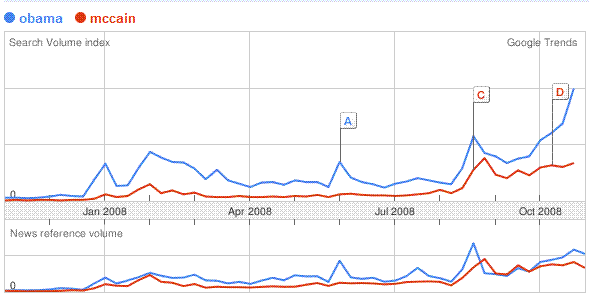Predicting the next Disruptive Innovation
In The Perils Of Extrapolation: Who Knows What The Next Disruptive Innovation Will Be Mike Masnick points out how important it is for an entrepreneur to be able to respond to changes. If you can accurately predict the next big innovation its easier for you to respond to change or even be first to market.
Traditionally forecasting doesn’t work well for innovation. Trend analysis isn’t very accurate for predicting the future because it’s looking at the past rather than what makes the future happen. That is why most people thing, “It’s always difficult to predict which innovation is actually going to hit”.
Predictive Innovation changes that and puts you in control, increasing profits, decreasing risks, and neutralizing competition.
Google Predicted the Election
As I pointed out in my book “Ron Paul Revolution: History in the Making” Google trends is much more accurate measure of the public opinion than limited polls. Since Google searches are what people are really interested in and can’t be swayed by the wording of the questions it’s more truthful. Also Google searches tracks every search so it is not as prone to sample bias.
I believe the polling methods used are part of the reason the Republican party failed. And even though the election looks like a big win for Obama and the Democrats I suspect they are missing very important aspects of what happened. Looking at people as groups rather than individuals hides what is really going on. People act as individuals not groups. Individuals have very different needs and desires. The entire election process forces people to pick a watered down version of what they really want.
There are enough people who don’t vote to win an election. That is the unserved long tail majority. In politics it might be possible to ignore the real majority by fighting over pieces of the small pie but businesses can’t do that and succeed. That huge group of potential customers are fuel for disruptive innovation. Any company that reaches that untapped group will jump to the industry leader.
Old methods of polling and marketing research won’t find these hidden non-buyers. Predictive Innovation can show you the untapped markets and how to reach them. As more distributed tools like Google Trends become available it becomes more important to learn how to use the Predictive Innovation Method.
3D Printer Brings Vision to the Poor
The same week that I found all the articles on 3D printers I found an amazing example that could dramatically improve life for billions of people in developing countries who cannot access, nor afford, prescription glasses.
Last weekend I went to get a new optical prescription so I could buy new contacts. The technician used fully automatic devices to check me for glaucoma and calculated my prescription. I had experienced the glaucoma device but the prescription device was new to me. I instantly knew how it worked just from seeing it. The machine reflects a pattern off your eye then adjusts lenses in the device until the reflected pattern matches the original. Incredibly, quick easy and cheap!
My mind raced through all the potential innovations stemming from this device. I came up with a long list which I’ll get to in a moment. What I am more excited about is an extremely innovative application of this same technique. In 2002 a student at MIT used a similar technique as part of a system to make glasses for the poor. This was exactly what I had thought of. This innovation went from an idea in 2002 to commercial usable device in 2006. That is amazing.
One of the reasons the idea was developed in such a short time was the use of a 3D printer to create a prototype. But probably even more important was it solved a previously impossible problem and opened up a gigantic market. There are 1 billion people who need inexpensive glasses. 
There are two obstacles to providing eye glasses to people in developing countries. Read more




 Predictive Innovation Training
Predictive Innovation Training Predictive Innovation: Core Skills Book
Predictive Innovation: Core Skills Book RoundSquareTriangle.com
RoundSquareTriangle.com